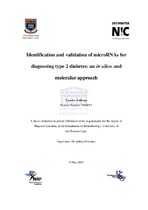| dc.description.abstract | Type 2 diabetes mellitus (T2DM), a metabolic disease characterized by chronic hyperglycemia, is the most prevalent form of diabetes globally, affecting approximately 95 % of the total number of people with diabetes i.e. approximately 366 million. Furthermore, it is also the most prevalent form in South Africa (SA), affecting approximately 3.5 million individuals. This disease and its adverse complications can be delayed or prevented if detected early. Standardized diagnostic tests for T2DM have a few limitations which include the inability to predict the future risk of normal glucose tolerance individuals developing T2DM, they are dependent on blood glucose concentration, its invasiveness, and they cannot specify between T1DM and T2DM. Therefore, there is a need for biomarkers which could be used as a tool for the early and specific detection of T2DM. MicroRNAs are small non-coding RNA molecules which play a key role in controlling gene expression and certain biological processes. Studies show that dysregulation of microRNAs may lead to various diseases including T2DM, and thus, may be useful biomarkers for disease detection. Therefore, identifying biomarkers like microRNAs as a tool for the early and specific detection of T2DM, have great potential for diagnostic purposes. The main focus of this investigation, therefore, is the early detection of T2DM by the identification and validation of novel biomarkers. Furthermore, based on previous studies, the aim of the investigation was to identify differentially expressed miRNAs as well as identify their potential target genes associated with the onset and progression of T2DM. An in silico approach was used to identify miRNAs found to be differentially expressed in the serum/plasma of T2DM individuals. Three publically available target prediction software were used for target gene prediction of the identified miRNA. The target genes were subjected to functional analysis using a web-based software, namely DAVID. Functions which were clustered with an enrichment score > 1.3 were considered significant. The ranked target genes mostly had gene ontologies linked with “transcription regulation”, “neuron signalling, and “metal ion binding”. The ranked target genes were then split into two lists – an up-regulated (ur) miRNA targeted gene list and a down-regulated (dr) miRNA targeted gene list. The in silico method used in this investigation produced a final total of 4 miRNAs: miR-dr-1, miR-ur-1, miR-ur-2, and miR-ur-3. Based on the bioinformatics results, miR-dr-1 and its target genes LDLR, PPARA and CAMTA1, seemed the most promising miRNA for biomarker validation, due to the function of the target genes being associated with T2DM onset and progression. The expression levels of the miRNAs were then profiled in kidney tissue of male Wistar rats that were on a high fat diet (HFD), streptozotocin (STZ)-induced T1DM, and non-diabetic control rats via qRT-PCR analysis. The hypothesis was that similar miRNA expression would be found in the HFD kidney samples compared to serum expression levels of the miRNA obtained from the two databases, since kidneys are involved in cleansing the blood from impurities. This hypothesis proved to be true for all miRNAs except for miR-ur-2. Additionally, miR-ur-1 seemed the most significant miRNA due to it having different expression ratios for T1DM and T2DM (i.e. -7.65 and 4.2 fold, respectively). Future work, therefore, include validation of the predicted target genes to the miRNAs of interest i.e. miR-dr-1: PPARA and LDLR and miR-ur-1: CACNB2, using molecular approaches such as the luciferase assays and western blots. | en_US |

